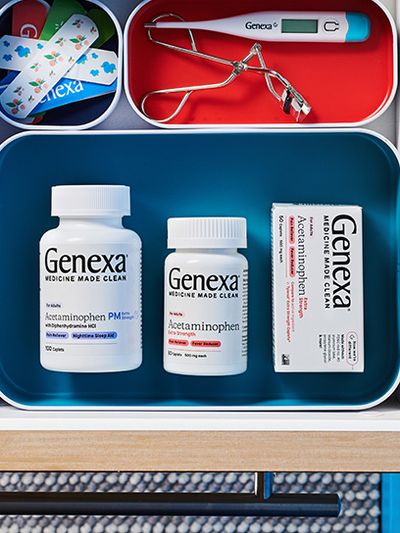What Does IU Mean?
Understanding The Medical Definition Of IU
Table of contents:
If you have ever wandered down the vitamin aisle and found it hard to read the label quantities on the bottles, you might have encountered both the metric system and a different unit of measurement known as “IU.” This article will tell you everything you need to know about IU so you can better understand the doses of certain medications and fat-soluble vitamins.
Overview of IU
IU stands for international units and is an internationally accepted measure of the biological activity of certain hormones and enzymes, as well as fat-soluble vitamins, among other drugs. The IU measurement can vary based on the biological activity, or potency, of the substance per unit of mass or volume.
IUs describe the biological effect that a specific dose of a substance can have on the body. Although it is possible to convert between metric units and IU, each product has a specific conversion factor so oftentimes it is easiest to rely only on IU.
History of the IU System
In the early 1900s, a publication entitled International Conference for the Unification of the Formulae of Potent Medicaments was released. This publication outlined the conversion factors for different vitamins. This information created a standard database of information that consumers and doctors could use to safely take vitamins.
Why Is IU Useful?
The international units system is useful, especially for vitamins, because the vitamins you take often come in several forms. For example, you can buy vitamin E as d-alpha-tocopherol or dl-alpha-tocopherol, or you can buy vitamin A as retinol or beta-carotene. Vitamin D can be bought as cholecalciferol or ergocalciferol.
Although the different vitamin forms offer similar nutritional and health benefits, they often have different levels of biological activity.
Essentially, you need different amounts of each different form to achieve the same biological effect.
For example, you might need to take more beta-carotene to see the same effect as retinol. Given that each form requires a different amount to achieve the same effect, it is not possible to standardize doses based on the weight of the vitamin. Labeling vitamins based on weight could make it difficult to know how much of each form you need to take to achieve the desired result.
International units are helpful because they offer both consumers and medical professionals an internationally agreed-upon way of identifying standard doses of medical products that achieve the same health effect. This standardization also eliminates any fear of taking too much of a given hormone or supplement.
What Products Are Measured in IU?
As previously mentioned, certain vitamins, hormones, enzymes, and drugs are all measured in IU. Although you might be tempted to convert IU measurements back into metric units of weight to better understand how much of a substance you are taking, it is important to remember that the IU system was created to make the dosage of vitamins easier.
Given that it is an internationally accepted standard, there is usually no need to make the conversion.
However, if you do need to convert from IU to the metric system, you need to know the specific conversion factor for the vitamin in which you are interested. If you want to go from IU to weight, you need to divide by the conversion factor. If you want to go from weight to IU, you need to multiply by the conversion factor.
Fat Soluble VS Insoluble
Only vitamins that are fat soluble are measured with the IU system. Vitamins are either classified as water-soluble or fat-soluble. The four fat-soluble vitamins are vitamins A, D, E, and K.
The term “fat-soluble” indicates that they do not dissolve in water, much like oil. Unlike water-soluble vitamins, excess fat-soluble vitamins are stored in your fat tissues and liver. Fat-soluble vitamins are often found in high-fat foods and can be better absorbed into your bloodstream when you eat them with healthy fats.
Are Any Vitamins Not Measured In IU?
Yes, some vitamins are not measured in IU. Vitamins such as vitamin C are measured in metric weights such as milligrams because they do not need to be standardized using the IU unit given that they usually come in only one form. Additionally, vitamins that are consumed in extremely small quantities, such as vitamin B12, are usually measured in micrograms.
Overview of Fat-Soluble Vitamins
This section will provide an overview of the four fat-soluble vitamins and their recommended daily intake for adults in IU.
Vitamin A
Vitamin A is the name of a group of compounds that are also known as retinoids. Usually, people consume vitamin A as retinol. However, it also comes in the form of retinal and retinoic acid, both of which are found in the body but scarcely found in food.
The daily recommended intake of vitamin A is 5,000 IU with an upper limit of 10,000 IU.
You may choose to take a vitamin A supplement for a wide variety of reasons. Vitamin A can help maintain the light-sensing cells in your eyes as well as the cells responsible for creating tear fluid. Additionally, vitamin A is essential for the growth and development of the body and can be beneficial for children who are growing slowly. Vitamin A also plays an important role in the overall health of your immune system and is vital for reproductive functioning in both men and women.
Vitamin D
You might have heard of vitamin D talked about in conjunction with sunshine or sunlight because it is made by your skin when you are exposed to sunlight. The two primary forms of vitamin D are vitamin D2 (ergocalciferol) and vitamin D3 (cholecalciferol). Vitamin D2 is usually found in mushrooms and other plants whereas vitamin D3 is found in foods from animals, such as eggs and fish oil. Vitamin D3 is also the form of vitamin D produced by your skin when you are exposed to sunlight.
The recommended intake of vitamin D for adults is 600 IU every day. Vitamin D is important for your bone health because it helps to regulate the level of calcium and phosphorus in your body. These two minerals are important for the growth and maintenance of your bones. Vitamin D also ensures that these minerals are absorbed from the food you eat. Additionally, vitamin D gives your immune system a boost, which can help protect you against infections.
Vitamin E
Vitamin E is the name for a family of eight antioxidants that are separated into two subgroups: tocopherols and tocotrienols. A large majority of the vitamin E in your blood is a tocopherol known as alpha-tocopherol. The best dietary source of vitamin E comes from vegetable oils, seeds, and nuts.
The suggested daily intake of vitamin E is 22.4 IU. As an antioxidant, vitamin E can protect your cells from harmful free radicals. Free radicals cause oxidative stress in your body and can lead to diseases, such as cancer. Vitamin E may work best when taken with other vitamins such as vitamin C, vitamin B3, and selenium. If you are at high risk for blood clots, taking large amounts of vitamin E can thin your blood and reduce the blood’s ability to clot.
Vitamin K
Much like vitamin E, vitamin K is a family of fat-soluble compounds that is divided into two main groups: vitamin K1 and vitamin K2. Vitamin K1, or phylloquinone, is found in plant-sourced foods like parsley, kale, and spinach, and it is the main form of dietary vitamin K. Vitamin K2, or menaquinone, is often found in animal-sourced products and fermented soy products. It is also produced in the body by gut bacteria in the colon.
Given that you only need to consume a small amount of vitamin K every day, the daily dosage is measured in micrograms (mcg). The recommended daily intake of vitamin K is 90 mcg for women and 120 mcg for men. However, most people receive the recommended intake of vitamin K through their diet. Vitamin K plays an integral role in blood clotting. It also supports bone health and helps prevent the calcification of blood vessels which may help reduce your risk of developing heart disease.
Conclusion
IU stands for international unit and is a measuring system for vitamins, hormones, enzymes, and other medical products. Unlike the metric system that measures weight, IU measures the biological activity of different products.
In other words, it is a measurement of how much you need of a certain product to feel its effect. This system is particularly useful for vitamins that come in several different forms because they may vary in strength depending on the variety.
Usually, IU is used to measure fat-soluble vitamins. The four fat-soluble vitamins are vitamin A, D, E, and K. Vitamin A is beneficial for eye maintenance as well as body growth and development. Vitamin D, also known as the “sunshine vitamin” plays an important role in bone health and supports the immune system. Vitamin E functions as a powerful antioxidant in your body, and vitamin K helps regulate blood clotting.






